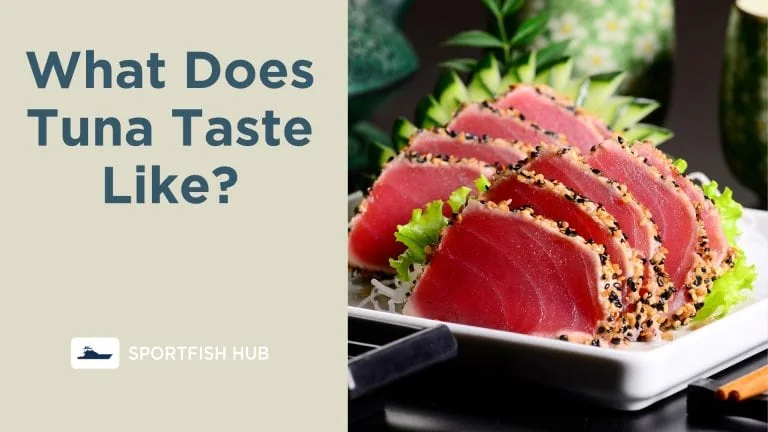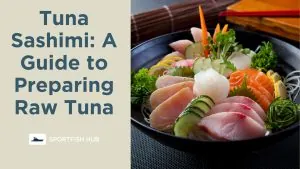Tuna is a very popular and nutritious fish that comes in many varieties, each with their own unique taste and texture. But what does tuna taste like? Here is a complete guide to the flavor of different tuna types and how to cook them.
See also: What is the Highest Temperature Allowed for Cold-Holding Tuna Salad?
An Overview of Tuna Taste
Most tuna has a soft, flaky texture and a mildly sweet, briny flavor. The flavor can range from very delicate to quite strong, while the texture varies from tender and buttery to firm and meaty.
In general:
- Raw tuna is more tender, delicate, and milder in flavor. Sushi grade tuna has a smooth, buttery texture.
- Cooked tuna is firmer in texture and often has a more pronounced flavor. Grilled or seared tuna has a pleasant char.
- Canned tuna tends to be quite salty and fishy in flavor with a dry, flaky texture.
Actual taste and texture depends on the specific variety, fat content, freshness, and preparation method.
See also: What Does Shark Taste Like?
Main Tuna Varieties and Their Flavor Profiles
There are over 15 species of tuna, but these are the most common varieties used for food:
Albacore Tuna
- Color: Whitish pink
- Texture: Firm, moist, meaty
- Flavor: Mild, slightly sweet
- Best Use: Grilled, canned
Albacore is the mildest and least “fishy” tasting tuna. It’s an excellent choice for people new to tuna.
Yellowfin/Ahi Tuna
- Color: Bright ruby red
- Texture: Smooth, tender when raw; flaky when cooked
- Flavor: Fuller-bodied, bolder, meatier
- Best Use: Sashimi, sushi, grilling
Yellowfin has a pleasantly fatty, rich taste. It’s a popular tuna for serving raw and grilled.
Bluefin Tuna
- Color: Dark red to purple-brown
- Texture: Silky, fatty when raw; moist and tender when cooked
- Flavor: Rich, buttery, beefy
- Best Use: Sushi, sashimi, grilling
Prized for its fatty, melty texture and rich umami flavor when eaten raw. The highest quality tuna.
Skipjack Tuna
- Color: Dark purplish red
- Texture: Firm
- Flavor: Strong, fishy
- Best Use: Canning
Has a much fishier flavor and is not typically eaten raw. Best for cooked applications like tuna casseroles.
Canned Tuna
- Color: Flaky pinkish beige
- Texture: Dry, flaky
- Flavor: Fishy, salty
- Best Use: Sandwiches, salads, pasta
Canned tuna is processed and cooked, so the texture is dry. The strong fishy taste comes from the canning process.
How Preparation Changes Tuna’s Taste and Texture
Raw Tuna
Eaten raw in sushi and sashimi, raw tuna has the most delicate flavor. Sushi grade tuna should have a smooth, silky texture with no fishy odor. Slight marinades like soy sauce or citrus dressings can complement the flavor.
Seared or Grilled Tuna
Quickly searing or grilling tuna over high heat creates a nicely charred exterior while keeping the center rare. This enhances the natural flavor of the fish. Brush with oil and sprinkle lightly with salt and pepper before cooking.
Baked or Simmered Tuna
Gentle cooking methods like baking or simmering make the flesh flaky and succulent. The mild sweetness becomes more pronounced. Slow cooking toughens the texture, so avoid overcooking.
Canned Tuna
Canning tuna involves precooking and packaging it in oil or brine. This draws out moisture, creating a dry, flaky texture. The canning liquid also gives it a very salty, fishy taste. Rinsing before use can reduce some of the saltiness.
Choosing the Best Tuna for Your Needs
- For sushi/sashimi: Splurge on quality sushi grade tuna like bigeye or bluefin. The buttery fat content and clean taste are perfect for raw consumption.
- For grilling: Yellowfin/ahi is a great choice with its rich meaty flavor that intensifies over an open flame. Firm albacore also holds up well.
- For salads: Flaky albacore works nicely in chilled dishes like tuna salad. The mild taste blends well with mayo and vegetables.
- For casseroles/pasta: Skipjack is affordable and has a bold flavor for holding up in cooked, saucy dishes.
- For sandwiches: Canned tuna is tasty and inexpensive. Look for tuna packed in olive oil for better texture and taste.
Health Benefits of Tuna
Tuna is rich in protein, vitamins, and heart-healthy omega-3 fatty acids. Health benefits include:
- High quality protein for building muscle and repairing cells
- Vitamins and minerals like B12, selenium, potassium, magnesium, and iron
- Omega-3 fatty acids to reduce inflammation and lower heart disease risk
- Low mercury levels compared to other large fish (especially canned and smaller varieties like skipjack)
Aim for two 3 oz. servings of tuna per week as recommended by health experts. Try seared ahi tuna tacos, albacore tuna salad sandwiches, or bluefin sushi for a delicious and nutritious seafood meal.
Final Thoughts
The flavor of tuna can range from rich and meaty when eaten raw as sushi to flaky and fishy when canned. Choosing high quality fresh or frozen tuna and avoiding overcooking are key to enjoying tuna’s natural tender texture and sweet, briny taste. Tuna is also loaded with protein and healthy fats, making it a prized culinary fish around the world.













